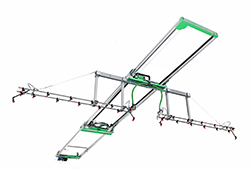Understanding Greenhouse Irrigation Needs
Plants in a greenhouse are grown in a controlled environment where temperature, humidity, and light levels can be regulated. However, their water needs must be managed carefully to avoid over or under-watering. The key to successful greenhouse irrigation is understanding the specific requirements of your plants, which can vary depending on the species, growth stage, and the growing medium used.
Types of Greenhouse Irrigation Systems
Drip Irrigation: Drip irrigation is one of the most efficient methods for delivering water directly to the plant's root zone. This system uses a network of tubes, emitters, and pipes to provide a slow, steady supply of water. Drip irrigation minimizes water wastage by targeting the root area and reducing evaporation and runoff. It is ideal for plants that require consistent moisture and can be easily automated to ensure precise water delivery.
Flood or Ebb and Flow Systems: This method involves periodically flooding the greenhouse beds with water and then allowing it to drain away. The water is usually pumped from a reservoir and distributed across the growing area. Ebb and flow systems are effective for plants grown in containers or trays and help to provide uniform moisture. However, they require careful monitoring to avoid waterlogging and ensure proper drainage.
Sprinkler Systems: Sprinkler irrigation systems mimic natural rainfall by distributing water over a wide area. This method is suitable for larger greenhouse spaces and can be used to water a variety of plant types. Modern sprinkler systems are often equipped with timers and adjustable nozzles to control the flow rate and coverage. While effective, Fertigation Systems sprinklers may lead to higher water usage and potential issues with leaf wetness and disease.
Mist Systems: Mist systems create a fine mist of water that helps maintain humidity levels in the greenhouse while providing some irrigation. This method is particularly useful for young seedlings and plants that thrive in high humidity. Mist systems can be combined with other irrigation methods to ensure comprehensive water management.
Best Practices for Greenhouse Irrigation
Monitor Soil Moisture: Regularly check the moisture levels of your growing medium to avoid over or under-watering. Soil moisture sensors can provide real-time data and help you adjust irrigation schedules accordingly. Understanding the moisture needs of different plant species is essential for optimizing their growth and health.
Use Water Wisely: Implement water-saving practices such as recycling runoff water, using rainwater harvesting systems, and reducing evaporation losses. Efficient water management not only conserves resources but also reduces the overall cost of greenhouse operations.
Maintain Irrigation Equipment: Regular maintenance of your irrigation system is crucial for its efficient operation. Clean filters, check for leaks, and ensure that all components are functioning correctly to prevent water wastage and ensure consistent delivery.
Adjust for Seasonal Changes: Water requirements can vary with seasonal changes, temperature fluctuations, and plant growth stages. Adjust your irrigation schedules and system settings to account for these variations and ensure that plants receive the appropriate amount of water throughout the year.






Comments